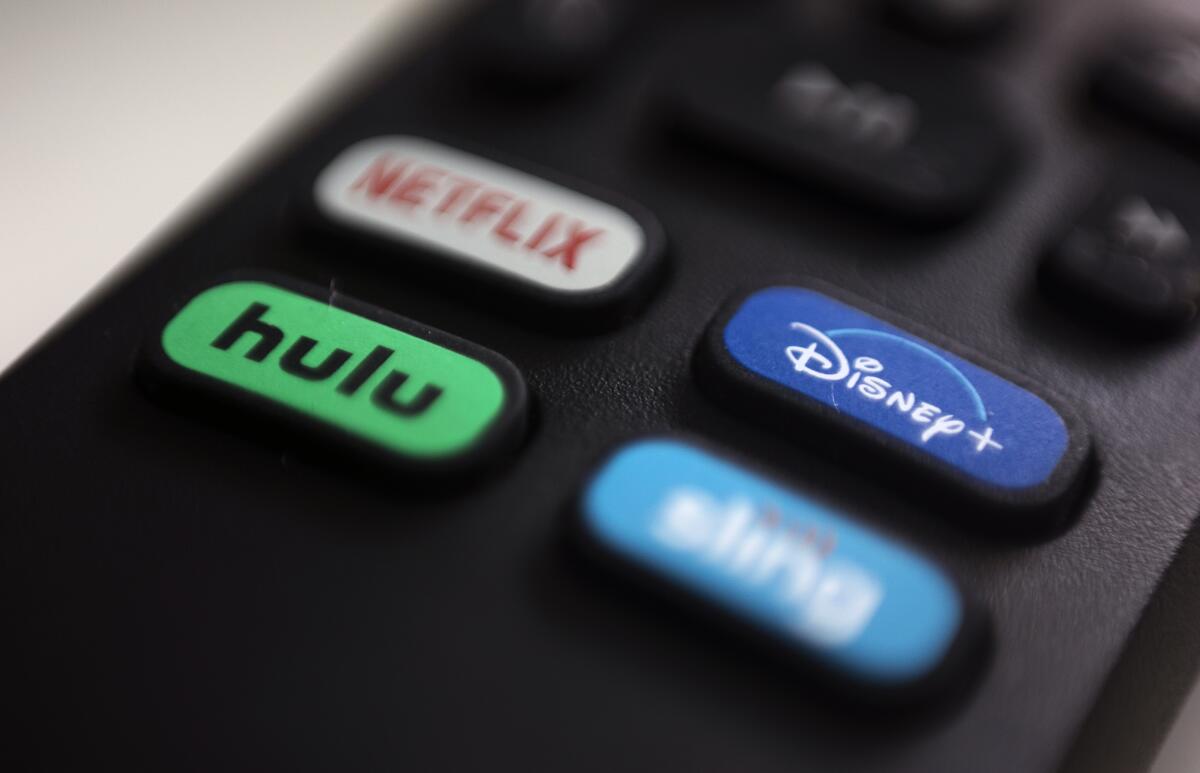Op-Ed: How the streaming wars are changing what you watch

Blockbusters are finally coming back to movie theaters. But the buzz is elsewhere in Hollywood. Streaming services are upending the film industryâs traditional model and consolidating power just as Hollywoodâs major studios did during its Golden Age in the 1930s.
AT&T is spinning off WarnerMedia to merge it with Discovery, forming a giant content conglomerate. Amazon is acquiring MGM and its library of thousands of films, television shows and James Bond. And rumors of other mergers are swirling.
Most viewers will have noticed these shifts by learning they need to sign up for yet another streaming service so they can watch the latest Marvel entry (Disney+), the âFriendsâ reunion (HBO Max) or the new Mark Wahlberg movie (Paramount+). The so-called streaming wars are dramatically changing how studios compete. As the power to produce and exhibit films online consolidates under the control of a few select companies, that shift will reshape what gets made and seen.
Consumers are seeing an explosion of content from streaming platforms such as Netflix, Hulu (owned by Disney) or Amazon Prime, and many have happily cut their cable cord over the last decade. But these platforms are slowly limiting the content they offer to what they produce themselves.
At this point, about half of Netflixâs shows are original programming; it expects to spend $17 billion on content this year. Disneyâs investors, likewise, are pressing the company aggressively to create a slew of content, including dozens of Star Wars and Marvel properties.
From the traditional consumer value lens, audiences are winning: Streaming subscriptions usually cost less than traditional cable bundles, while providing access to a broad range of titles as libraries consolidate. But the market looks very different from the vantage point of smaller competitors: independent producers and distributors such as A24, Neon and Kino Lorber.
Small producers have always had to fight against the big studios to get their films seen. But they also relied on a robust independent theater market to help them break out. âMoonlight,â âTangerineâ and âParasite,â for example, built their audiences first through word of mouth before becoming must-see theatrical hits and eventual award winners.
This arrangement was sustained by both producers and exhibitors wanting these films to financially succeed. Even when studio subsidiaries like Sony Pictures Classics distribute art-house films, they have to compete on the same playing field.
Under streaming, however, the switch to a subscription service upends that dynamic. Once a film is on the site, Netflix does not necessarily make an effort to make sure audiences hit play, and often it âburiesâ licensed films to prioritize its exclusive content.
While co-founder Ted Sarandos claims that a Netflix hit makes âa billion dollars of box office in terms of cultural impact,â when was the last time someone mentioned, say, â6 Undergroundâ or âThunder Forceâ? Or go to Amazon Prime Videoâs home page and see how hard it can be to find Barry Jenkinsâ highly acclaimed series âThe Underground Railroad.â The new goal seems to hope for âGame of Thronesâ-like hits, with the rest of the content as simply arbitrary filler.
This might seem like a bad business plan, but the strategy is about forcing competitors to leave the market. Netflix has been outspending any other would-be distributors â paying $30 million for the indie drama âMalcolm & Marie,â and over $400 million for sequels to âKnives Outâ â though it is unclear whether these films actually can earn that much in returns. But what Netflix does get is one fewer competitor who could potentially profit from those movies or produce films that turn audiences away from Netflix, even for a night.
This power also lets Netflix dictate creative possibilities. Joshua Glick has charted how Netflix has upended the documentary market by pushing filmmakers toward a less political âstory firstâ approach. Production teams are having to adjust to Netflixâs decision to ban the most popular digital cameras in Hollywood in its productions, which has led to many complaints of blurry cinematography. And perhaps most important is how Netflix has set up precarious labor dynamics, paying higher fees to creatives to run shows for two seasons before abruptly canceling them. Many individuals could work for other studios, but as streaming giants dictate more decisions, they have no choice but to fall in line.
The new dynamics of streaming have also introduced new complications into how Hollywood compensates its talent. Because of a lack of direct box-office revenue, top box-office talent rarely end up sharing in profits and residuals, and Netflixâs arbitrary viewership data â based on only two minutes of viewing â has created more confusion about which films really succeed. This uncertainty might scare away potential movie financers while forcing top talent to tie themselves to studios and tried-and-true franchises rather than choose their own projects.
Skeptics will say that independent filmmakers will just hustle, as they always have. But that becomes harder when digital distribution â and the need to access these primary platforms to make any profit â strangles the industry. Giants such as Netflix are positioned to control which films get made and how, without necessarily following the preferences of consumers.
But antitrust offers a solution. For more than a century, the U.S. has used antitrust laws to break up or curb monopolies that strangle competition. It is time to investigate whether streaming giants should divest their film production divisions and operate exclusively as online exhibitors.
While that might seem drastic, history proved this out when the landmark 1948 case United States vs. Paramount Pictures, and the subsequent consent decrees, forced the studios to divest themselves of their theater chains and end their unfair contract practices with independent theaters. The end of the studio system allowed studios and independent producers to compete simultaneously, creating a mix of spectacle blockbusters, social issue dramas, foreign art films, teen flicks and eventually the New Hollywood of the 1970s.
President Biden sets a robust antitrust agenda and Lina Khan, the new chair of the Federal Trade Commission, is rethinking how to frame competition. They have the opportunity to expand their focus beyond Big Tech and toward Hollywood.
The old consent decrees from the Paramount case were ended in 2020, but consolidation in Hollywoodâs streaming landscape is creating an anti-competitive market as pernicious as the domination of Google, Apple and Facebook in digital infrastructure.
Federal and state regulators are suing Google, accusing it of abusing its market power, and some are discussing how a breakup could restore competition. Shouldnât Netflix face the same scrutiny?
Peter Labuza teaches film history and media industries at San Jose State and UC Berkeley. He is currently writing a book on the history of Hollywoodâs entertainment law firms.
More to Read
A cure for the common opinion
Get thought-provoking perspectives with our weekly newsletter.
You may occasionally receive promotional content from the Los Angeles Times.










